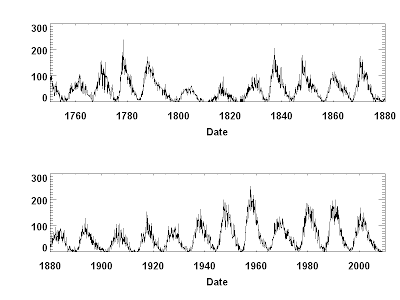The Sunspot Number
Scientists track solar cycles by counting sunspots -- cool planet-sized areas on the Sun where intense magnetic loops poke through the star's visible surface.
Counting sunspots is not as straightforward as it sounds. Suppose you looked at the Sun through a pair of (properly filtered) low power binoculars -- you might be able to see two or three large spots. An observer peering through a high-powered telescope might see 10 or 20. A powerful space-based observatory could see even more -- say, 50 to 100. Which is the correct sunspot number?
There are two official sunspot numbers in common use. The first, the daily "Boulder Sunspot Number," is computed by the NOAA Space Environment Center using a formula devised by Rudolph Wolf in 1848:
R=k (10g+s),
where R is the sunspot number; g is the number of sunspot groups on the solar disk; s is the total number of individual spots in all the groups; and k is a variable scaling factor (usually <1 --="" accounts="" and="" binoculars="" combine="" conditions="" data="" each="" etc.="" for="" from="" i="" its="" lots="" observatories="" observing="" of="" own="" scientists="" space="" telescope="" telescopes="" that="" the="" type="" with="">k
factor -- to arrive at a daily value.
The Boulder number (reported daily on SpaceWeather.com) is usually about 25% higher than the second official index, the "International Sunspot Number," published daily by the Solar Influences Data Center in Belgium. Both the Boulder and the International numbers are calculated from the same basic formula, but they incorporate data from different observatories.
As a rule of thumb, if you divide either of the official sunspot numbers by 15, you'll get the approximate number of individual sunspots visible on the solar disk if you look at the Sun by projecting its image on a paper plate with a small telescope.
A more complete link can be found at: http://spaceweather.com/glossary/sunspotnumber.html

No comments:
Post a Comment